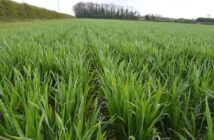With the discovery of the reduced performance of SDHIs against net blotch in one AHDB trial in 2016 the question now is what does it mean for barley disease control programmes?
For Philip Simons of Prime Agriculture he isn’t sure it will have a significant impact at the moment. “Although there has been some shift in the sensitivity of some straight SDHIs we don’t use them as straights. There’s been no shift in the EC50 values of prothioconazole, so field control is largely unaffected. But strobs are offering little help nowadays,” he notes.
But he does say it highlights the importance of stewardship best practice. “We need to be providing the maximum protection for all our chemistry, and be following FRAG UK guidelines. Our preferred azole choice might be prothioconazole but SDHIs, strobs, CTL and morpholines all have a place in broad spectrum barley disease control programmes
“With Ramularia and Rhynchosporium to consider as well we are often looking at a three way mix anyway. What’s important is to use these products at sensible rates, and go at the right growth stage timing.”
Indeed Mr Simons is just as concerned with Ramularia. A spore trap located in Norfolk for three seasons found levels comparable to Scottish sites and Mr Simons saw more of the disease last summer. “Not only am I finding it in spring crops but winter ones too. Its spread is probably more weather related as leaf wetness, particularly at stem extension, is an important trigger. With recent seasons beeing typified with more humid weather it has fuelled inoculum for the following season. We can’t discount seed infection which could be a factor but the weather has been particularly favourable.”
He believes that weather could be adding to stress factors too. Plants exposed to sudden changes in light, temperature or waterlogging are more vulnerable to disease. “We know stressed plants are less able to withstand the disease. Perhaps we need to be checking leaf undersides for Ramularia spores more regularly. It is a hard disease to identify with reddish brown spots being mistaken for stress.”
Barley disease control is usually built around two prothioconazole based applications but an additional T0 fungicide might be needed in high pressure situations. “The best form of defence is an azole SDHI mix such as SiltraXpro, (prothioconazole + bixafen) applied at the standard timings. We do see some dirty varieties remaining popular choices, so a T0 can help keep a lid on barley disease. Other fungicide groups such as morpholines can be useful here but there is also a good argument for prothioconazole as a T0,” he adds.
Professor Fiona Burnett of SRUC is concerned that it is the start of more widespread resistance issues and says control should involve a combination of cultural and chemical actions. “The frequency of mutated isolates found in testing has been steadily increasing and we see that coming through in terms of reduced efficacy in trial test situations where straight products are used. But crucially we don’t apply them straight so in balanced mixtures with other effective partners such as prothioconazole net blotch is still well managed. SDHIs mixed in this way offer broad spectrum disease control against the spectrum of barley diseases but the trial result highlights the need for stewardship best practice going forward.
“What is important is that we make the most of varietal resistance and use SDHIs with other modes of action to protect them,” she concludes.




